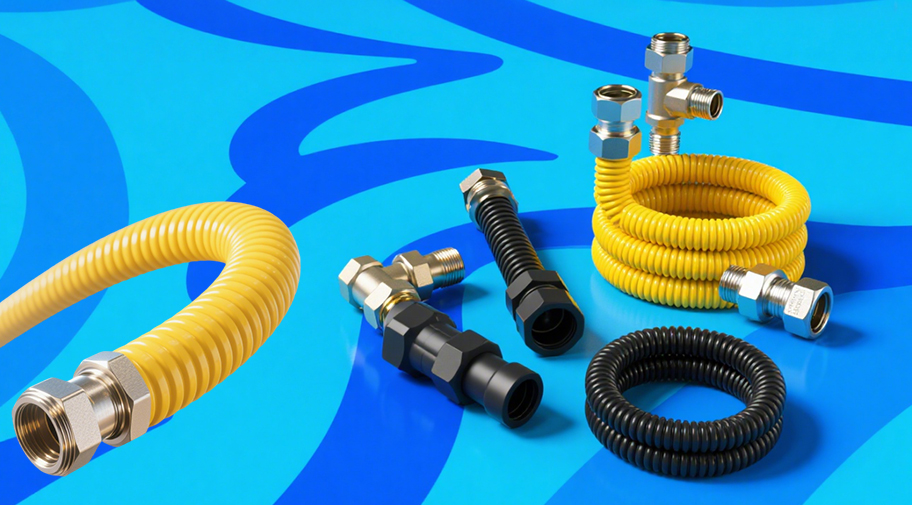-
+86-574-62166708
-
-









In industries such as industrial manufacturing, chemical engineering, and precision instruments, sealing hoses are key components that ensure the safe transmission of media (gases, liquids) and prevent leakage. Stainless steel bellows, with their unique metallic properties and structural design, have become an ideal choice for scenarios requiring high sealing performance. They can effectively address the limitations of traditional rubber or plastic sealing hoses in terms of temperature resistance, pressure resistance, and corrosion resistance. The following elaborates on specific solutions from multiple dimensions.
Compatibility between Core Performance Advantages and Sealing Requirements
The core demands of sealing hoses are zero leakage, resistance to media, adaptability to environmental changes (temperature and pressure fluctuations), and a certain degree of flexible compensation capability. The characteristics of stainless steel below can precisely meet these requirements:
Excellent Sealing Reliability: Adopting an integrally formed bellows structure made of stainless steel (such as grades 304 and 316), combined with precision-machined connection ends (such as flanges and threaded interfaces), it can achieve tight metal-to-metal sealing. Alternatively, it can further enhance the sealing effect by matching with high-temperature-resistant/corrosion-resistant gaskets (such as PTFE gaskets). It can effectively prevent leakage of gases and liquids (including corrosive media and high-temperature fluids), with a leakage rate as low as 1×10⁻⁹ Pa·m³/s or less.
Wide Temperature Range and Pressure Resistance: It can work stably within a temperature range of -270℃ (ultra-low temperature) to 600℃ (high temperature), far exceeding that of rubber hoses (usually -40℃ to 120℃). At the same time, it can withstand high working pressures (conventional specifications can reach 1.6-10MPa, and specially customized models can reach higher), making it suitable for sealed connections in high-pressure pipeline systems.
Corrosion Resistance and Media Compatibility: 304 stainless steel can resist erosion from water, steam, and weak acids and alkalis, while 316 stainless steel can withstand strongly corrosive media such as seawater, chloride salts, and organic solvents. This avoids sealing failure caused by material aging or erosion by media, making it particularly suitable for corrosive environments in industries such as chemical engineering and pharmaceuticals.
Flexible Compensation and Vibration Resistance: The annular corrugated structure of the bellows endows it with good axial, lateral, and angular compensation capabilities. It can absorb displacements caused by thermal expansion and contraction of pipelines, equipment vibration, or installation misalignment, reducing stress on sealed interfaces and lowering the risk of leakage due to rigid connections.
Structural Stability and Long Service Life: The metal material is not easily aged and has fatigue resistance. It can maintain structural integrity under long-term alternating stresses (such as vibration and pressure fluctuations), with a service life of more than 10 years, far longer than that of rubber hoses (usually 1-3 years).
Typical Application Scenarios
As sealing hoses, stainless steel bellows can widely replace traditional sealing hoses to solve sealing problems in different scenarios:
Sealed Connections in Industrial Pipelines
Used for sealed connections between equipment such as pumps, valves, pressure vessels, and pipelines, especially suitable for pipeline systems transporting high-temperature steam, hot oil, and corrosive liquids, such as the sealing of inlet/outlet pipes of chemical reactors and flexible sealed connections of steam pipelines in power plants.
In pipelines of low-temperature equipment such as LNG and liquid nitrogen, they can be used as sealing hoses to withstand ultra-low temperatures and avoid leakage caused by low-temperature embrittlement.
Sealing of Precision Instruments and Meters
In the gas and liquid path systems of analytical instruments (such as gas chromatographs and mass spectrometers), they can be used as sealing hoses to ensure the clean transmission and zero leakage of carrier gases and samples, ensuring analysis accuracy.
At the connection ends of metering equipment (such as flow meters and pressure gauges), flexible sealing reduces the impact of vibration on metering accuracy and prevents medium leakage.
Sealing Protection of Mechanical Equipment
For pipeline sealing in hydraulic and pneumatic systems, especially for connections of moving parts of equipment (such as oil cylinders and air cylinders), the flexible compensation of bellows can absorb movement displacements, ensuring sealing while avoiding pipeline wear.
For sealing of cooling water pipes and fuel pipes of power equipment such as engines and compressors, they can withstand high temperatures and vibrations during equipment operation, preventing oil and water leakage from causing faults.
Sealing Requirements in Special Environments
In marine engineering, they are used for sealed connections of ship deck pipelines and underwater equipment, resisting seawater corrosion and hull vibration.
In the nuclear industry, sealing hoses for radioactive medium transmission have radiation resistance and high sealing characteristics to ensure safety.
Key Selection Points and Installation Specifications
1. Scientific Selection
Caliber and Length: Select calibers such as DN6-DN300 according to the medium flow requirements. The length should be determined based on the pipeline displacement compensation, with a certain flexible margin reserved (usually 10%-20% longer than the rigid connection length).
Pressure and Temperature: According to the system working pressure (design pressure should be ≥1.5 times the working pressure) and temperature range, select below of corresponding pressure levels and materials (such as 310S stainless steel is preferred for high-temperature working conditions).
Medium Characteristics: For corrosive media, select 304, 316, or Hastelloy materials according to the medium composition (such as chloride ion concentration). If necessary, perform inner wall coating (such as PTFE coating) to enhance corrosion resistance.
Connection Method: Select connection forms such as flanges (socket welding, butt welding), threads (NPT, G threads), and quick connectors according to the equipment interface type, ensuring sealing matching with the interface (such as the flange sealing surface should be compatible with the gasket material).
2. Installation Specifications
Avoid Over-bending and Twisting: During installation, the bending radius must not be less than the bending radius specified by the product (usually 3-6 times the pipe diameter). Twisting of the bellows is strictly prohibited to prevent damage to the corrugated structure, which may affect sealing and service life.
Fixing and Guiding: For long-distance installation, fixed supports should be set at both ends of the bellows, and guide supports should be added in the middle to avoid displacement of the bellows caused by pipeline self-weight or medium impact, ensuring uniform stress on the sealed interface.
Sealing Surface Treatment: Before connection, clean oil stains and burrs on flange surfaces and threaded interfaces. For flange connections, tighten bolts evenly (tighten diagonally step by step). For threaded connections, apply sealant (such as PTFE tape) to enhance sealing performance.
Leakage Test: After installation, a pressure test (pneumatic or hydraulic) must be carried out. The test pressure is 1.25 times the working pressure, and the pressure is maintained for 30 minutes without a pressure drop or leakage to be qualified.
Application Benefits
Reduced Leakage Risk: Compared with traditional rubber sealing hoses, the leakage rate of stainless steel bellows is reduced by more than 90%, reducing safety accidents caused by medium leakage (such as fires caused by leakage of flammable and explosive media, and personal injury caused by leakage of corrosive media).
Reduced Maintenance Costs: The long service life characteristic extends the replacement cycle by 3-5 times. At the same time, corrosion resistance and temperature resistance reduce the maintenance frequency caused by material aging, and the comprehensive maintenance cost can be saved by more than 50%.
Expanded Application Boundaries: It can work stably in environments (high temperature, high pressure, strong corrosion) that traditional sealing hoses cannot adapt to, providing reliable sealing solutions for special working conditions.
Improved System Stability: The flexible compensation capability reduces the impact of pipeline stress on equipment interfaces, protects precision equipment such as pumps and valves, and extends their service life.
Summary
As sealing hoses, stainless steel bellows achieve comprehensive benefits of "high sealing, resistance, long service life, and easy installation" through the inherent advantages of metal materials and the flexible design of the corrugated structure. They are an ideal choice for upgrading and replacing traditional hoses in the industrial sealing field, especially in scenarios with strict requirements on sealing performance and environmental adaptability, providing a solid guarantee for the safe and stable operation of the system.